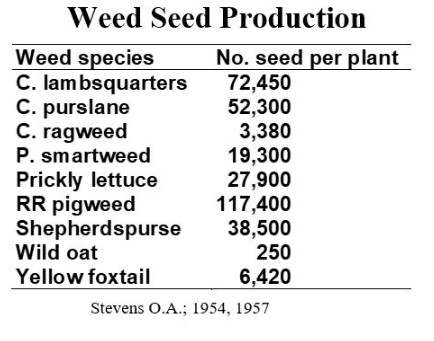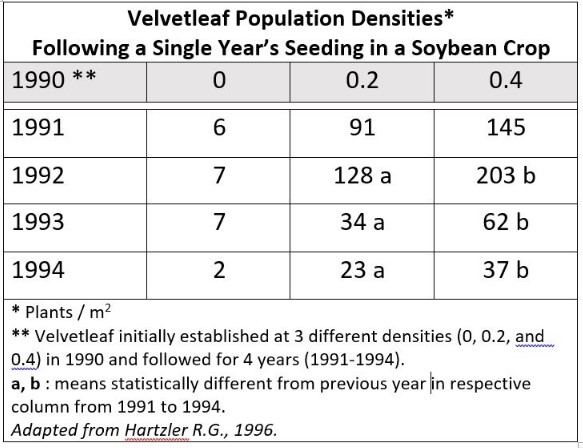The last post demonstrated the remarkable ability and unique features of aphids that allow them to rapidly boost their numbers and colonize their hosts in favorable conditions. What about weeds? What features give them the ability to rapidly colonize a potted crop or planted field? Many plants become weeds because they have the powerful trick of producing many many seeds. Seeds are dispersed by wind, insects, animals, or by their association with our nursery tools and machinery. Often, these seeds are long-lived in the soil. Consider these statistics:

Probably some unfortunate graduate students or field assistants in 1954 were given the task to count weed seed of hundreds of common weed species from about 50 plant families in North Dakota. The table above is just a sampling (Stevens 1957). In most cases a single plant, judged to be of average size and growing where competition was low, was harvested at maturity or when a maximum number of seeds could be obtained. The plants were air dried for two weeks or more, threshed and cleaned to re-move immature seeds, empty florets, etc. All of the sampling methods are described in the Stevens reference given below.
So basically left on their own, weeds have a profound ability to produce seed. Some seed are not viable, some germinate immediately, and some persist, perhaps for years, in the soil as a “seed bank”. This bank represents the holdings of weed seeds in the soil. Place a “deposit” of seed in this bank, and your “interest” is compounded in a big way. An interesting experiment with velvetleaf (Abutilon theophrasti) an important weed in soybean crops demonstrated this (Hatzler, 1996).

Velvetleaf is a prolific seed producer and seeds are long-lived. In 1990, replicated experimental plots were planted with soybean and then with one of three velvetleaf densities: 0, 0.2, and 0.4 plants per square meter. In subsequent years, the experiments were maintained in a corn-soybean rotation. Weed densities were determined at crop harvest for four years. As seen above-- even with competition from the crop plants-- velvetleaf density increased dramatically for years following the very sparse initial planting of the weed. There were even some velvetleaf plants seen in the untreated “0” plots, even though the plots were hand weeded to reduce seed production for 5 years prior to initiating the study.
The numbers of weed seeds in soil banks can range from near 0 to over 1,000,00 per square yard, and most weed seeds are between 0 and 5 years old. A small number of seed can remain viable for decades or more. With this knowledge, one of the most important principles of weed management is to “never let weeds go to seed”. Never.
Source: ucanr.edu